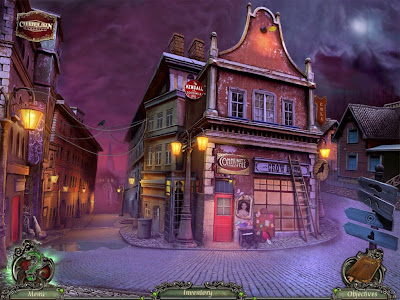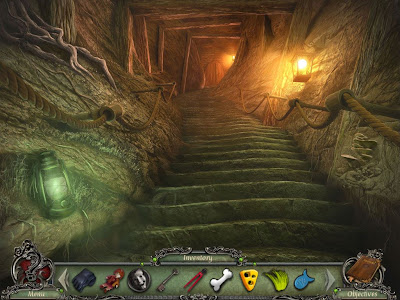PLAY Enjoy!!
HIDDEN OBJECT GAMES
PC | ENG | 567 Mb | UNRAR & PLAY
OS: Windows XP/Windows Vista/Windows 7 | CPU: 1.4 GHz | RAM: 512 MB | DirectX: 8.1 | Hard Drive: 586 MB
Thank: Big Fish Games & Orneon
Solve the Mystery of Everlake in Rite of Passage: The Perfect Show! You are a teacher in Everlake, a small town recently struck by a series of unexplained child abductions. When your student goes missing, it is up to you to take up the role of a detective and save the children. On your quest you will uncover secrets, solve challenging problems and encounter enigmatic characters with unclear motives. In the town of Everlake nothing is at it seems, as the story of crime, mystery and supernatural events unfolds before your eyes. At the center of it all stands the old puppet theater and its elusive patron. The Perfect Show is coming.
The Collector’s Edition includes:
- Bonus Content
- Integrated Strategy Guide
- Beautiful Wallpapers
ประกอบด้วย:
- ฉาก Bonus พิเศษ
- คู่มือการเล่น
- วอลเปเปอร์
------------------------------------------------------------------------------------------------------------
Turbobit
Rite of Passage - The Perfect Show Collector's Edition.part1.rar
Rite of Passage - The Perfect Show Collector's Edition.part2.rar
REVIEW : RELATED STORY
Phoenix (Mythological Bird)
The phoenix, or phenix, is a mythical sacred firebird that can be found in the mythologies of the Arabian, Persians, Greeks, Romans, Egyptians, Cchinese, Indians and (according to Sanchuniathon) Phoenicians.
It is described as a bird with a colorful plumage and a tail of gold and scarlet (or purple, blue, and green according to some legends). It has a 500 to 1000 year life-cycle, near the end of which it builds itself a nest of twigs that then ignites; both nest and bird burn fiercely and are reduced to ashes, from which a new, young phoenix or phoenix egg arises, reborn anew to live again. The new phoenix is destined to live as long as its old self. In some stories, the new phoenix embalms the ashes of its old self in an egg made of myrrh and deposits it in the Egyptian city of Heliopolis (literally "sun-city" in Greek). It is said that the bird's cry is that of a beautiful song. The Phoenix's ability to be reborn from its own ashes implies that it is immortal, though in some stories the new Phoenix is merely the offspring of the older one. In very few stories they are able to change into people.
- The Legend of the Phoenix
The Phoenix is known in various forms and by various names throughout the Middle and Far East, the Mediterranean, and Europe, as a symbol of resurrection. The name Phoenix may have come from the Greek phoinix and may be related to phoinos (blood-red). Although it was an enormous bird, it had certain characteristics of the eagle, pheasant, and the peacock.
The earliest known Greek reference to the Phoenix was by Hesoid in the eighth century B.C.E. Such Greek and Roman writers as Tacitus, Ovid, Pliny, Herodotus, and Hesoid referred to the Phoenix either as the Arabian Bird or the Egyptian Bird. An extremely gentle creature, it was said to weep tears of incense, while its blood was balsam.
There are two ancient records of first-hand sightings of a Phoenix: one by Pliny, who saw one exhibited in the Roman Forum during the reign of the Emperor Claudius; another by Clemont in the first century C.E.
The Phoenix was a graceful bird, with brilliant plumage and a distinctive tuft of feathers at the back of its head. There are at least three different descriptions of the plumage colors of the Phoenix. One says that the head, breast, and back are scarlet or reddish-gold, and the iridescent wings are many colors. Its feet are a Tyrian purple hue, while its eyes are sea-blue. Another says the body is plum-colored with a scarlet back and wing feathers, a golden head, and a long tail of rose and azure. The third description states that the Phoenix is a royal purple with a golden neck and head. It is possible that these descriptions are of the Phoenix in various stages of its life.
Tradition says that the Phoenix fed only on air, harming no other creature. It lived a solitary life in a far-away land, coming to human-inhabited land only when it was ready to die. The length of a Phoenix's life differs from ancient writer to writer; most believed that it lived for a thousand years.
When the Phoenix knew its time had come, it flew to Arabia where it gathered myrrh, laudanum, nard, and cassia. Carrying a great load of these fragrances in its wings, the Phoenix flew on to Phoenicia. There, it chose the tallest palm tree and built a nest in it from the essences it had brought. At the next dawn, the great bird faced the rising Sun and sang in a beautiful voice. The heat of the Sun ignited the fragrant spices, and the Phoenix died in its own funeral pyre.
After nine days, a fledgling Phoenix rose out of the ashes. A few days later, when its wings were strong enough, the young Phoenix gathered the ashes of its parent and flew them to Heliopolis in Egypt. Thousands of ordinary birds accompanied it on its journey. There, the Phoenix put the ashes of its parent on the altar in the Sun temple. Then it flew toward the east and its distant home.
Other writers of the Phoenix story disagree on several points. Some said that instead of flying to Phoenicia with its spices, the Phoenix flew directly to the temple at Heliopolis and built its funeral pyre on the altar there. Others believed that the priest of the Sun temple gathered the spices and prepared the next for the Phoenix. A few writers recorded that the Phoenix did not rise straight from the ashes, but rather spent three days in a worm-like form before turning into the glorious Phoenix.
The Phoenix never died permanently. Legend says it existed when the universe was created and that it knows secrets of life and reincarnation even the deities do not know.
Humans are fascinated by the sweet song of the Phoenix, and the bird is friendly to humans, although it seldom concerns itself with human affairs.
A similar mythological Egyptian bird was the Bennu, a heron-like bird. The Bennu was born in a spice-lined nest in a sycamore tree. It too made its own funeral pyre in which it died. Its first flight, after being reborn, was accompanied by thousands of ordinary birds. In fact, "Bennu" in Egyptian and "Phoenix" in Greek both mean "date palm." The Bennu was sacred to Osiris and Ra, and a symbol of the Sun and resurrection. It also represented the morning star.
The Egyptian Phoenix was called the "Lord of jubilees," and was considered to be the ba (spirit) of the Sun God Ra. At one point in the Book of the Dead, the deceased says, "I have gone forth as a Phoenix." In Heliopolis, the Bennu was said to live in the benbenstone (obelisk) or in the sacred willow.
.jpg)
Queen Elizabeth I had a Phoenix engraved on her medals; Mary Queen of Scots also used the same emblem. Jane Seymour, who died giving birth to Edward VI, had a Phoenix crest, which her son later used.
In Mesopotamian art, the Phoenix may have been symbolized by the horned and winged solar disk. Ancient bas-reliefs show this winged disk also having tail-feathers, legs, and claws of a bird. Often this winged disk also had horns. The winged disk of Abura Mazdah on a relief at Persepolis distinctly shows this disk with tail-feathers and bird's legs and feet.
Alchemists used the Phoenix to symbolize the color red and the successful end of a process, while medieval Hermeticists used the Phoenix as a symbol of alchemical transmutation. The word Phoenix was also used to identify one of the secret alchemical formulae.
The ancient Mysteries used the sign of the Phoenix to symbolize the immortality of the human soul and the great truths of esoteric philosophies revealed only through special initiations. In some ancient Mystery Schools, accepted initiates were referred to as Phoenixes, or those who had been "born again."
นกฟีนิกซ์ : นกอมตะ
ฟีนิกซ์ (Phoenix) เป็นสิ่งมีชีวิตที่คล้ายนก ปรากฏในตำนานของหลายๆ ชาติ ในลักษณะที่คล้ายกันแต่แตกต่างกันในบางรายละเอียด
- ฟีนิกซ์ของอียิปต์โบราณ
ฟีนิกซ์ปรากฏตำนานของพวกอียิปต์โบราณ ในฐานะของสัตว์เทพในตำนานซึ่งคู่ควรแก่การบูชา ยกย่อง เคารพ ฟีนิกซ์เกี่ยวข้องกับเทพแห่งไฟ ดังนั้นจะสังเกตได้ว่า ขนนกของฟีนิกซ์นั้นจะออกเป็นประกายเหลืองทองคล้ายเปลวไฟ บ้างก็ว่าปกคลุมด้วยเปลวไฟทั้งตัวทีเดียว
ขนาดของนกฟีนิกซ์นี้จะมีขนาดเท่านกอินทรีตัวโต จงอยปากและส่วนขาเป็นสีทอง ประกายขนสีแดงถึงเหลืองทอง มีเสียงร้องที่ไพเราะดังเสียงดนตรี รูปร่างสวยสง่างาม บางครั้งหยิ่งผยอง บางครั้งเปี่ยมด้วยความเป็นมิตร บางตำนานเล่าว่านกนี้สามารถฟื้นชีวิตให้กับผู้ตายได้ และสามารถฟื้นพลังทั้งหมดให้กลับสู่ปกติได้ เนื่องจากเป็นสัตว์เวทย์ตัวหนึ่งภายใต้เทพแห่งไฟ บางครั้งจะพบว่าสามารถใช้มนตร์ไฟได้ ฟีนิกซ์เป็นสัตว์ที่นิสัยอ่อนโยน เพลงของฟีนิกซ์มีเวทมนตร์สามารถกระตุ้นความกล้าหาญแห่งจิตใจบริสุทธิ์ และทำให้เกิดความกลัวในจิตใจที่คิดร้าย น้ำตาของนกฟีนิกซ์มีพลังในการรักษาบาดแผลได้
นกฟีนิกซ์นี้เป็นสัญลักษณ์แห่งความเป็นอมตะ มีชีวิตยั่งยืนนิรันดร์ เพราะมันสามารถฟื้นคืนชีพได้ เมื่อร่างกายสิ้นอายุขัย (500 ปี หรือ 1,461 ปี) ตัวจะลุกเป็นไฟ จากนั้นฟีนิกซ์ก็จะฟื้นจากกองขี้เถ้ามาเป็นลูกนกใหม่
- ฟีนิกซ์ของกรีกโบราณ
ว่ากันว่าเรื่องราวเริ่มแรกของนกฟีนิกซ์มาจากวรรณกรรมกรีกโบราณที่ชื่อว่า Account of Egypt ของกวีเฮโรโดตัส ประมาณ 430 ปี ก่อนคริสตกาล ตามตำนานกล่าวว่า นกฟีนิกซ์มีอายุ 500 ปี เมื่อถึงเวลาที่ใกล้จะหมดอายุขัย นกฟีนิกซ์จะล่วงรู้ถึงชะตากรรม มันจะสร้างรังจากไม้เครื่องเทศที่มีกลิ่นหอม แล้วนั่งคอยที่กองฟืนไม้หอมและร้องเพลงอย่างสำราญใจ เมื่อแสงอาทิตย์แรกสาดส่อง นกฟีนิกซ์จะแผดเผาตนเองกลายเป็นเถ้าถ่าน จากเถ้าถ่านนั้นนกฟีนิกซ์หนุ่มตัวใหม่จะกำเนิดขึ้น ภารกิจแรกที่ฟีนิกซ์หนุ่มต้องกระทำก็คือ การรวบรวมเถ้าถ่านของพ่อแม่แล้วนำไปฝังที่วิหารเฮลิโอโปลิส หรือนครแห่งตะวันในอียิปต์ จากนั้นก็จะบินกลับมาที่อาระเบียและใช้ชีวิตอยู่จนกว่าจะเปลี่ยนร่างอีกครั้ง
จุดกำเนิดตำนานเกี่ยวกับนกฟีนิกซ์นี้ อาจมาจากหนังสือแห่งเวทมนตร์เล่มหนึ่งที่ชื่อว่า Book of Dead ซึ่งกล่าวถึงนกยักษ์ลักษณะคล้ายนกฟีนิกซ์ นกยักษ์ตัวนี้เป็นต้นแบบของวิญญาณอิสระที่ลุกขึ้นมาจากกองเพลิง และบินไปยังเฮลิโอโปลิสเพื่อประกาศยุคใหม่ เพราะว่าดวงอาทิตย์ได้สาดแสงไล่หลังนกที่บินจากตะวันออกไปยังตะวันตก นกจึงปรากฏตัวพร้อมกับเช้าวันใหม่จนกลายเป็นสัญลักษณ์แห่งไฟและดวงอาทิตย์ไปในที่สุด
การที่นกฟีนิกซ์สามารถเกิดใหม่ได้จากเถ้าถ่านของตัวเอง จึงกลายเป็นตัวแทนของการฟื้นคืนจากความตาย ซึ่งสร้างแรงบันดาลใจให้แก่กวีและนักเขียนหลายต่อหลายท่าน จนเรื่องราวแห่งนกฟีนิกซ์แทรกซึมเข้าไปอยู่ในวรรณกรรมยุโรปหลายต่อหลายเรื่อง
ยังมีเรื่องเล่าของฟีนิกซ์ที่ค่อนข้างจะสอดคล้องกันที่ว่า ในอดีตกาล เทพเจ้าแห่งดวงอาทิตย์ หรือที่รู้จักกันคือ เทพอพอลโล ได้เห็นความงดงามของฟีนิกซ์ จึงได้ขอให้มาเป็นนกข้างกายพระองค์ พร้อมกับให้พรวิเศษคือ “ชีวิตอมตะ” แก่นกฟีนิกซ์เป็นการตอบแทน พอได้พรวิเศษ เจ้านกฟีนิกซ์ก็สุดแสนจะดีใจ มันค้อมศีรษะเพื่อแสดงความคารวะ ในขณะที่เริ่มเปล่งเสียงร้องขับขานบทเพลงสรรเสริญ “สุริยเทพผู้รุ่งโรจน์ สุริยเทพผู้สง่างาม ข้าจะเป็นประหนึ่งผู้ขับขานบทเพลงเพียงเพื่อท่านและเป็นนกฟีนิกซ์แห่งสุริยเทพแต่เพียงผู้เดียว ชั่วนิรันดร์” และทุกวันจะบินไปยังทางตะวันออกเพื่อคอยร้องเพลงขับกล่อมเทพเจ้าแห่งดวง อาทิตย์ในช่วงเช้าตรู่
ทว่าเมื่อเวลาผ่านไป 500 ปี เจ้านกฟีนิกซ์ก็เริ่มแก่ตัวลง ไม่มีแรงที่จะร้องเพลงขับกล่อมเทพเจ้าได้เช่นเดิม นกฟีนิกซ์จึงได้ร้องขอเทพเจ้าแห่งดวงอาทิตย์ ช่วยทำให้ตัวเองกลับมาเป็นหนุ่มและแข็งแรงอีกครั้ง แต่เหมือนคำขอดังกล่าวจะไม่ได้รับการตอบรับใดๆ ดังนั้น เจ้านกฟีนิกซ์จึงตัดสินใจบินกลับรังของตัวเอง และระหว่างทางได้พบบรรดาไม้หอมนานาชนิดจึงเก็บไปด้วย เพื่อนำมาสร้างรังบนยอดต้นปาล์ม หลังจากนั้นก็ร้องขอให้เทพเจ้าแห่งดวงอาทิตย์ประทานความหนุ่มและความแข็งแรงให้อีกครั้ง
ไม่นานท้องฟ้าก็ปั่นป่วนและเกิดฟ้าผ่าลงบนรังของเจ้าฟีนิกซ์ ส่งผลให้รังและเจ้านกฟีนิกซ์ถูกเผาจนเหลือแต่เถ้าถ่าน และกลายมาเป็นนกฟีนิกซ์หนุ่มตัวใหม่ พร้อมกับเริ่มทำหน้าที่ขับกล่อมเสียงเพลงให้แก่เทพเจ้าแห่งดวงอาทิตย์ได้อีกครั้ง และทุกๆ 500 ปีล่วงผ่านไป นกใหญ่แห่งสุริยะตัวนี้ก็จะบินกลับมายังที่เดิม เพื่อให้สุริยเทพเผาตัวเองเพื่อการกลับมาสู่นกตัวใหม่ที่แข็งแกร่ง
ในตำนานกรีกยังเล่าขานอีกว่า นกฟีนิกซ์จะอาศัยอยู่ในแถบอาระเบีย โดยจะอาศัยอยู่ในบริเวณแหล่งน้ำที่มีอากาศเย็น ทุกๆ เช้าที่ตะวันเริ่มสาดแสง เทพเจ้าแห่งดวงอาทิตย์จะต้องหยุดรถม้าเพื่อฟังเสียงร้องอันแสนไพเราะของนกฟีนิกซ์ยามที่มันเล่นน้ำทุกวัน อาหารโปรดของเจ้านกชนิดนี้ก็สุดแสนจะศิวิไลซ์ นกฟีนิกซ์ชอบกินสายลมอ่อนๆ น้ำอมฤต น้ำค้าง หรือหมอกบริสุทธิ์ที่ลอยขึ้นมาจากแม่น้ำและทะเล
.jpg) ยังมีการพูดถึงคุณลักษณะพิเศษของเจ้าฟีนิกซ์เอาไว้อีกว่า ฟีนิกซ์เป็นสัตว์ที่มีนิสัยอ่อนโยน สามารถหายตัวและปรากฏตัวใหม่ตามใจนึกเช่นเดียวกับตัวดิริคอว์ล เพลงของนกฟีนิกซ์มีเวทมนตร์ สามารถกระตุ้นความกล้าหาญแห่งจิตใจที่บริสุทธิ์ และทำให้เกิดความกลัวในจิตใจที่คิดร้าย และน้ำตาของนกฟีนิกซ์ก็เป็นดังโอสถทิพย์แห่งสวรรค์ที่มีพลังในการรักษาบาดแผลและชุบชีวิตได้ แต่ถึงกระนั้นเจ้านกฟีนิกซ์ก็ยากจะหลั่งน้ำตาให้ใคร ยกเว้นเสียแต่ว่าคนผู้นั้นจะมีคุณงามความดีมากพอที่จะกลับมามีชีวิตใหม่อีกครั้ง
ยังมีการพูดถึงคุณลักษณะพิเศษของเจ้าฟีนิกซ์เอาไว้อีกว่า ฟีนิกซ์เป็นสัตว์ที่มีนิสัยอ่อนโยน สามารถหายตัวและปรากฏตัวใหม่ตามใจนึกเช่นเดียวกับตัวดิริคอว์ล เพลงของนกฟีนิกซ์มีเวทมนตร์ สามารถกระตุ้นความกล้าหาญแห่งจิตใจที่บริสุทธิ์ และทำให้เกิดความกลัวในจิตใจที่คิดร้าย และน้ำตาของนกฟีนิกซ์ก็เป็นดังโอสถทิพย์แห่งสวรรค์ที่มีพลังในการรักษาบาดแผลและชุบชีวิตได้ แต่ถึงกระนั้นเจ้านกฟีนิกซ์ก็ยากจะหลั่งน้ำตาให้ใคร ยกเว้นเสียแต่ว่าคนผู้นั้นจะมีคุณงามความดีมากพอที่จะกลับมามีชีวิตใหม่อีกครั้ง จากวงจรชีวิตทั้งหมดทั้งมวลของเจ้านกฟีนิกซ์นี้เอง ที่ทำให้ในตำนานของกรีกและโรมันเชื่อว่า นกฟีนิกซ์เป็นสัญลักษณ์ของการมีชีวิตเป็นอมตะ การฟื้นคืนชีพ และเกี่ยวข้องกับเทพเจ้าแห่งดวงอาทิตย์ หรือแม้กระทั่งในช่วงต้นของคริสต์ศาสนาก็ได้มีการนำเอารูปนกฟีนิกซ์มาสลัก เป็นลวดลายบนหินปิดหลุมฝังศพ ซึ่งหมายถึงผู้ที่จากไปจะฟื้นคืนชีพขึ้นมาอีกครั้งนั่นเอง
Source:
http://www.polarissite.net/LegendPhoenix.htm. The Legend of the Phoenix from Magickal, Mystical Creatures, by D.J. Conway.
http://th.wikipedia.org/wiki/นกฟีนิกซ์
http://th.wikipedia.org/wiki/นกฟีนิกซ์





.jpg)
.jpg)
No comments:
Post a Comment